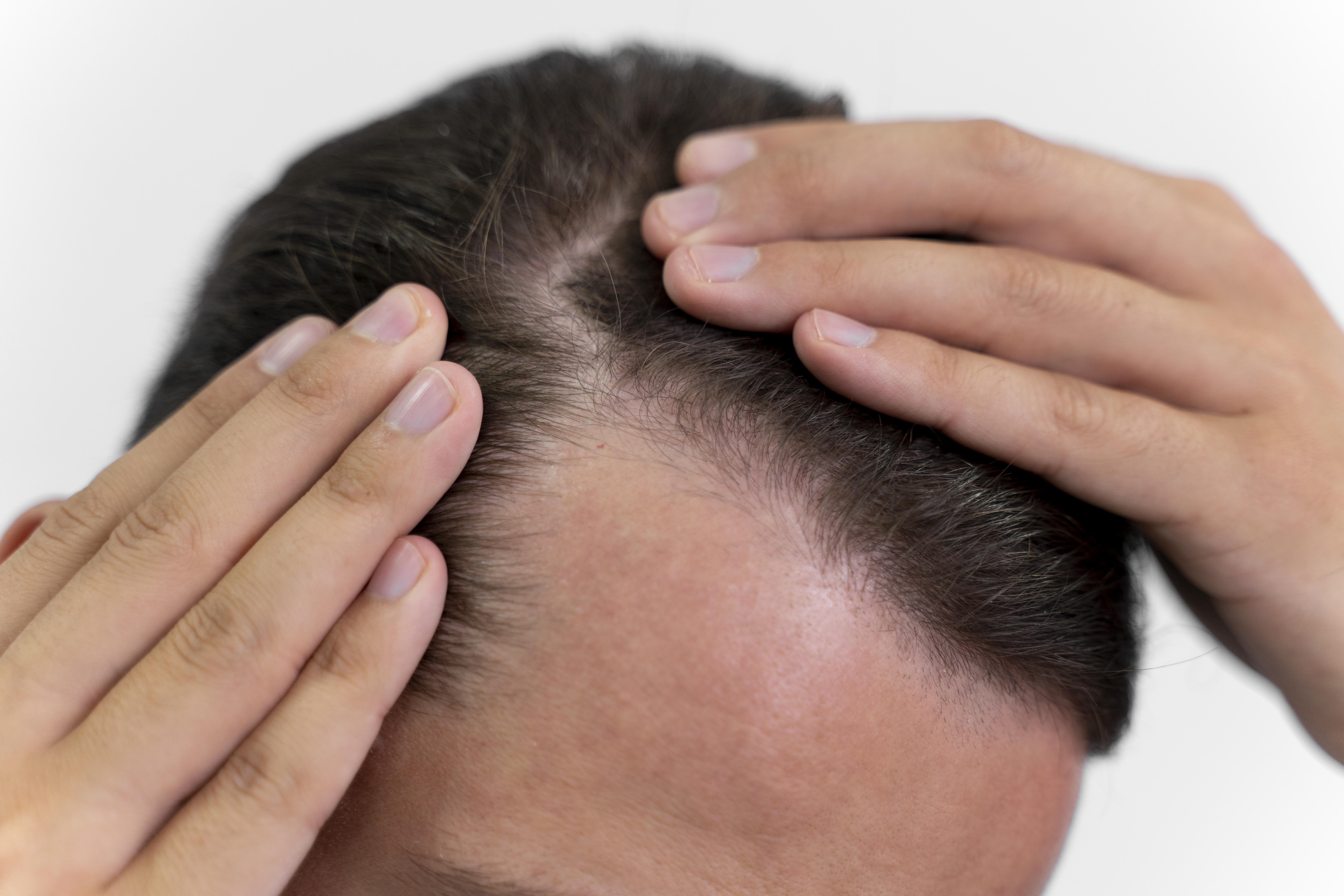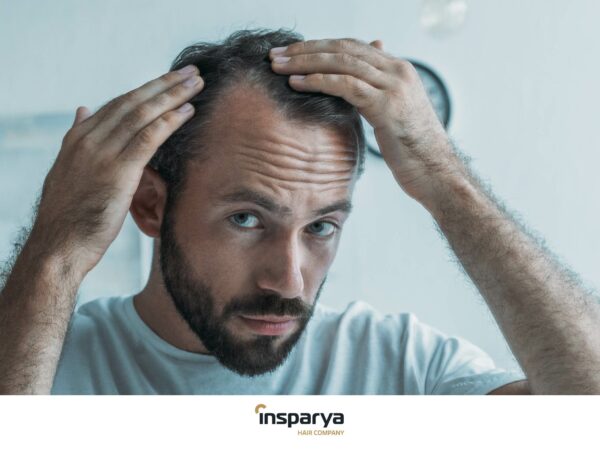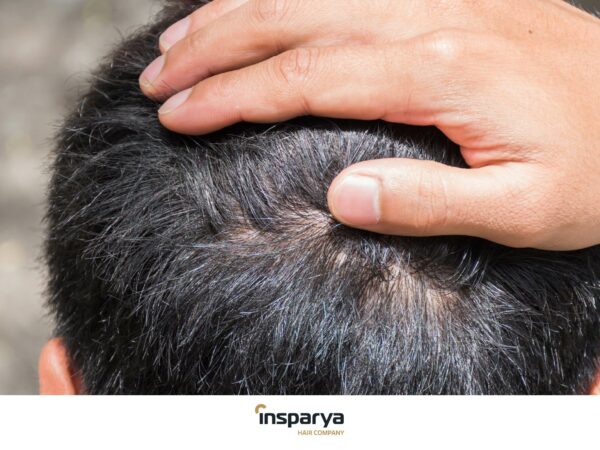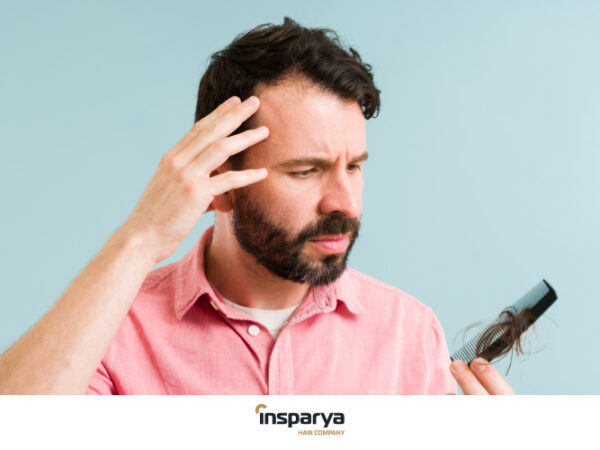
Receding hairline: will I go bald?
- Why do receding hairlines appear?
- Types of receding hairline
- How do I know if I will have receding hairline?
- Do receding hairlines mean certain baldness?
- Solutions to disguise or treat receding hairlines
- Hairstyles and haircuts to disguise receding hairlines
- Medical and cosmetic treatments
- Hair transplantation as a permanent solution
- Frequently asked questions about hair ingrown hairs
Hair loss can affect men and women of any age, although androgenic alopecia affects men to a much greater extent. Knowing if you are suffering from accelerated hair loss that can lead to alopecia is key to finding a solution as soon as possible and preventing further loss.
To begin with, it should be stated that we all lose hair every day of our lives. Some people keep most of their hair into old age, though they are the minority. Most people, over the years, lose density and thickness or suffer total hair loss. But we all lose between 100 and 120 hairs a day.
However, the important thing is not how much hair falls out, but how much it regenerates. It is natural that with age our follicles lose vigour and stop generating hair, to a greater or lesser extent.
So how do you distinguish androgenic alopecia from the simple action of time? Your hairline can begin to recede in your twenties, but not pose an aesthetic problem until decades later. Genetic predisposition is key when it comes to whether this becomes alopecia or not.
Why do receding hairlines appear?
The appearance of receding hairline is the first symptom of alopecia, but it is possible that at some point they stop, and no hair is lost from the rest of the head. Even so, it is important to detect their appearance in order to keep an eye on them and put ourselves in the hands of specialists who will decide whether we should start treatment to stop their advance.
Causes of receding hairlines
Receding hairline is a common phenomenon that can arise for several reasons:
- Genetic: the most common cause of receding hairline is androgenetic alopecia. This type of hair loss is influenced by hereditary factors and is more common in men, although it can also affect women.
- Hormones: Hormonal changes, especially those related to dihydrotestosterone (DHT), can affect follicular units and cause receding hairline formation.
- Age: As we age, hair density and thickness tend to decrease, which can lead to receding hairline. Age-related hair loss is a natural and progressive process.
- Stress and lifestyle habits: Continuous stress and certain habits, such as an unbalanced diet or smoking, can contribute to hair loss and receding hairline.
- Health problems: some illnesses and treatments, such as thyroid problems or chemotherapy, can cause hair loss and receding hairline. It is important to consult a doctor if an underlying cause is suspected.
At what age can receding hairline appear?
Although receding hairline usually starts to appear from the age of 20, it is possible to have receding hairline as early as 18. There are less frequent cases where receding hairline appears earlier or is delayed by decades, but the most common is between the ages of 20-30, with hair loss accelerating with age.
Types of receding hairline
Receding hairlines can be more or less pronounced, and are easier to notice when hair is worn short. Thus, rather than types of receding hairline, there are degrees of alopecia, which in the male pattern follow the Norwood-Hamilton scale.
In grades 1 and 2 the loss of density is slight and occurs mainly on the frontal line. In grade 2, less hair is noticeable in the area of the receding hairline, something that may have gone unnoticed until then. As we progress through the grades the loss is greater and areas such as the crown of the head are added.
M or V-shaped recesses
M or V-shaped receding hairline is the most common type of receding hairline and is characterised by a recession at the temples that forms a hairline with an M or V appearance. This type of receding hairline is often one of the first signs of androgenetic alopecia. In men, it is a typical manifestation of hair loss that may begin to be noticed from an early age and may progress over time.
U-shaped receding hairline
U-shaped receding hairline is characterised by a more uniform receding hairline in the frontal area, creating a hairline that resembles an inverted U-shape. Unlike M- or V-shaped receding hairlines, this type of receding hairline tends to be more gradual and less pronounced at the temples, affecting the frontal hairline more evenly.
Asymmetrical receding hairline
Asymmetrical receding hairline occurs when hair loss is not equal on both sides of the forehead. This can cause an uneven hairline. This can be caused by a number of factors, such as stress, certain hairstyling habits or even genetics. These receding hairlines can be less predictable and vary quite a bit in appearance from person to person.
How do I know if I will have receding hairline?
Genetic and hereditary factors
Genetics play a crucial role in the appearance of receding hairlines. If there is a history of baldness or pronounced receding hairline in your family, especially in the paternal line, you are more likely to develop receding hairline as well. Genetic inheritance can determine not only the predisposition to hair loss, but also at what age and with what intensity it will occur.

Early signs of alopecia
The first signs of alopecia usually manifest themselves in the form of receding hairline in the temple area. If you notice your hairline starting to recede into a ‘V’ or ‘M’ shape, you may be developing receding hairline. Look at the density and quality of the hair in this area; if it looks thinner or falls out more easily, this is an early indicator of alopecia. Also, if you find more hair on your pillow, in your brush or in the shower, these are also signs that you may be losing hair.
Do receding hairlines mean certain baldness?
The appearance of receding hairline, which is nothing more than hair loss in the temple area, is the first sign of alopecia. Although it is possible that at some point they stop and no hair is lost from the rest of the head, it is important to detect their appearance in order to keep an eye on them and place ourselves in the hands of specialists who will decide whether we should begin treatment to stop their advance.
However, if you notice that in addition to the receding hairline, your forehead is becoming wider and the hair is thinning on the crown of your head, it is more than likely that you are going to go bald. If you add to this an excess of grease or dandruff, hair loss when washing or combing and scalp discomfort, it is time to see a hair health specialist to stop this incipient androgenic alopecia.
In short, baldness in men usually begins with a loss of density at the temples, the so-called receding hairline. It is also possible for the hair to fall out first and most profusely in the crown area.
Progression of receding hairline to baldness
The progression of receding hairline to baldness follows a characteristic pattern that begins with a slight receding hairline at the temples. This process may be the first sign of androgenetic alopecia, resulting in thinning hair, which will eventually fall out mainly on the front and top of the head. As it progresses, receding hairline may widen and connect with balding areas at the crown of the head, forming characteristic patterns such as the familiar ‘M’ shape in men and a generalised scattering in women.

Is it possible to stop receding hairline progression?
The best way to prevent receding hairline is to have healthy habits. This means eating a complete diet, rich in biotin and vitamins A, B, C and D, as well as avoiding a sedentary lifestyle, alcohol and tobacco, and always using quality hair products.
If you notice that your receding hairline is getting longer, it is advisable to include an anti-hair loss shampoo such as Insparya Prevent-HA in your daily routine. Its composition rich in hyaluronic acid and seaweed not only prevents hair loss, but also strengthens weakened, thin and brittle hair, repairs, regenerates and revitalises. Apply it with gentle circular massages to stimulate blood circulation and thus facilitate the nourishment of the follicles. It is also recommended that you pay attention to the subsequent drying, which should always be with a soft towel and without rubbing, avoiding as far as possible the hairdryer or using it cold.
In short, what you should do to avoid going bald is to maintain a healthy lifestyle in which stress is reduced to a minimum, diet prevents nutritional deficits and physical activity is daily. Add to this the use of a good shampoo and our mesotherapy and PRP and you will be doing your part to mitigate hair loss or, at least, delay the process.
Solutions to disguise or treat receding hairlines
Hairstyles and haircuts to disguise receding hairlines
Receding hairline can be tackled in different ways depending on preference and severity. To conceal receding hairline, strategic hairstyles such as long fringes or layered cuts can create an appearance of increased hair density. Also, wearing hair short or using volumizing products can help reduce the visibility of the areas that have suffered the most thinning.
Medical and cosmetic treatments
To boost hair growth in areas affected by baldness, it is essential to maintain a healthy scalp. This involves maintaining a nutrient-rich diet, avoiding excessive stress and using specific, quality hair health products. In addition, it is advisable to consult a specialist doctor if you notice any changes or discomfort. Only with a personalised diagnosis is it possible to propose an effective treatment.
Medications such as Minoxidil and Dutasteride or hair treatments such as mesoHAir+ hair mesotherapy, ActivePlasma or 4GenInsparya stimulation treatment are widely used. These practices improve scalp health and can reactivate dormant follicular units, generating new hair.
Also, including cosmetic products with ingredients such as hyaluronic acid and peptides in the daily hygiene routine can moisturise and nourish the scalp and improve its overall condition.
Hair transplantation as a permanent solution
Currently, hair transplantation is considered the only definitive solution against alopecia. With this intervention it is possible to permanently repopulate the affected areas. Unlike other treatments that can only slow down hair loss or stimulate temporary growth, hair transplantation redistributes healthy follicular units from the donor area to the areas with alopecia. In addition, the transplanted hair is not subject to the same hormonal conditions that cause hair loss in other areas. This ensures that, once grafted, the hair will not fall out again.
This ensures that the transplanted hair grows in a natural and long-lasting way. This technique is especially effective for people suffering from androgenic alopecia, the most common type of alopecia.
It should also be noted that hair transplantation has a high success and satisfaction rate among patients. At Insparya we have already performed more than 60 thousand successful hair transplants during the more than fifteen years of experience in our clinics.
Frequently asked questions about hair ingrown hairs
Can I have receding hairline as a teenager?
Receding hairline can begin to appear as early as adolescence, especially in individuals with a genetic predisposition to male pattern baldness. It is normal to have receding hairline at the age of 17, although it is not the norm.
Does receding hairline also affect women?
Although less common than in men, receding hairline can affect women. Female pattern alopecia can also include thinning of the frontal hairline, which can be treated with medical and cosmetic options.
Is there any way to prevent receding hairline?
There are no completely effective methods to prevent receding hairlines if there is a genetic predisposition. However, maintaining a healthy lifestyle, avoiding stress and using preventative treatments such as Minoxidil can help slow the progression of hair loss.




